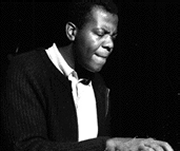 |
Larry YoungOrgan |
|---|
 |
Larry YoungOrgan |
|---|
"His technique is out of sight; he has very big ears and a beautiful time conception. Larry Young is where jazz is going on the organ!"
--Woody Shaw
"One thing about Larry Young:" Grant Green was emphasizing as he talked about this album, "is that he's really an organist. He knows that instrument; and furthermore, unlike some other organ players in jazz, Larry never gets in your way. On the contrary, he keeps building in and around what you're doing while always listening so that his comping is always a great help. He's much more flexible than organists usually are, and that makes it possible for him to comp specifically for each different player. Man, he even comps in a particular way for drums.
"Another thing:" Green continued, "is that Larry is always identifiable right away. You know it's him. It's his sound, his imagination and the way he creates melodic lines. His sense of melody is very fresh and very much his own."
The organ skills of Larry Young, furthermore, are, in a sense, a continuation of a family tradition. As Leonard Feather points out in his notes for Talkin' About, a Grant Green album on which Larry Young and Elvin Jones also appear, "Larry is the first important young jazz organist to claim second-generation status in this profession." Larry Young, Senior, is an organist and was the first major musical influence on his son. The father, moreover, provided an organ in the family home so that Larry Young, Junior, who had studied piano, could gravitate easily and at his own pace to the organ.
The younger Larry Young was born on October 7, 1940. His background includes study of both classical and jazz music. (Bud Powell was a particular force in Young's early indoctrination into modern jazz.) From about 1951 to 1958, Young was relatively inactive musically; but a strongly reawakened interest in the organ, encouraged by his father, propelled Young back into music in 1958. After a rhythm and blues apprenticeship, Young gained wider experience with Lou Donaldson; worked around New York and New Jersey with Kenny Dorham, Hank Mobley and Tommy Turrentine, among others; and then began heading his own units.
Young went to Paris in November, 1964, and has since created a European following through his quartet at Le Chat Qui Peche. One reason for his decision to spend some time in Europe is Young's persistent concern with widening his experience so that he can express a greater diversity of emotions and insights in his music. But Young has no intention of becoming an expatriate. With regard to jazz, he points out, "the States are the basis of it all and I won't stay in Europe so long that I'll lose my roots."
The strength of Young's roots in the blues and in corollary foundation blocks of the jazz language are evident throughout this album. Also clear is Young's variegated imagination as a composer. In Larry Young, Blue Note has one of the more rare contemporary phenomena in jazz--thoroughly skilled jazz organist who recognizes the virtues of clarity and spareness as well as the need to keep attuned to the individual, expressive needs and directions of his colleagues.
--NAT HENTOFF, from the liner notes,
Into Somethin', Blue Note.
A selected discography of Larry Young albums.
| Find Larry Young on Amazon.com | Find Larry Young on eBay.com | |
|---|---|---|
| Larry Young CDs on Amazon | Larry Young CDs on eBay | |
| Larry Young LPs on eBay | ||
| Larry Young BOOKs on eBay |
 Music |
 Home |
 Musicians |
|---|
|
Any comments, additions or suggestions should be adressed to:
The Hard Bop Homepage / Eric B. Olsen / ebolsen@juno.com |
Other Web Sites:
The Film Noir 'net A History of Horror The War Film Web Author Eric B. Olsen |